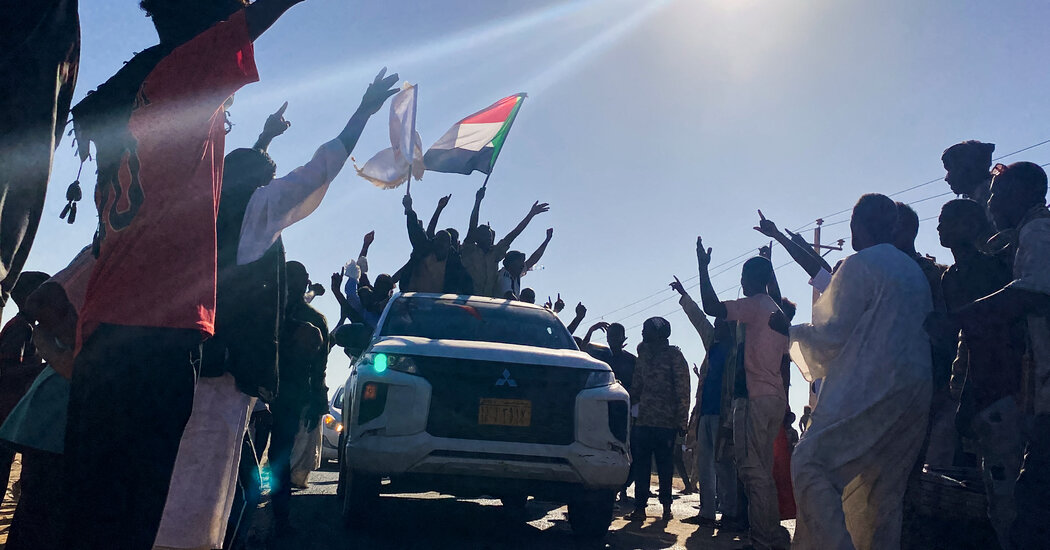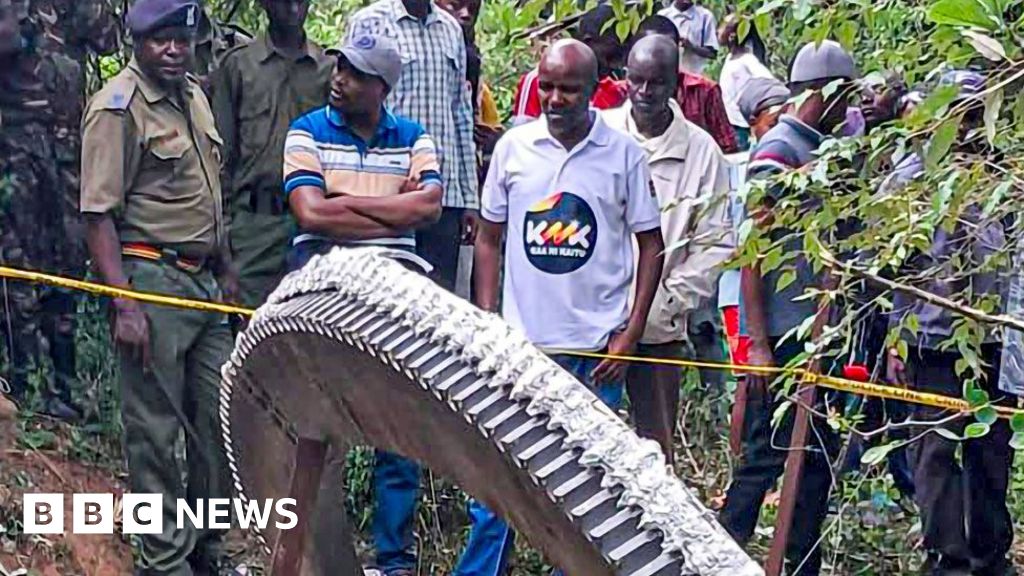
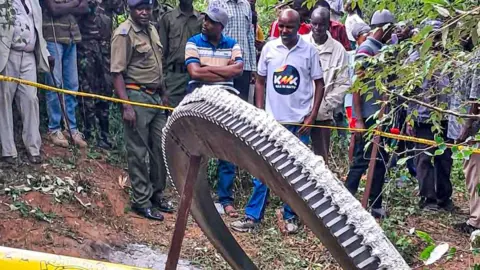 Getty Photographs
Getty PhotographsAn eerie whizzing pitch adopted by way of a large increase startled Kenyan villagers enjoyable just lately one afternoon with folk and buddies.
“It sounded like a bomb, I was shocked. I started looking around, also wondering if it was gunshots,” Stephen Mangoka, a 75-year-old farmer from Makueni county’s Mukuku village, informed the BBC.
“I looked up in the sky to see if there was smoke. Nothing.
“I on a tight schedule to the street to test if there were an crash. Additionally, not anything. This is when somebody informed me that one thing had fallen from the skies.”
In fact, a massive round metal object had plummeted from above landing on farmland near a dry riverbed – and it was piping hot.
“We discovered a large piece of steel that was once very purple so we needed to watch for it to chill sooner than any individual may way it,” said Ann Kanuna, who told us she owns the land where the object fell.
The giant ring took around two hours to cool down and turn grey – but it had already become a sensation with people arriving to look at it.
The rest of that Monday afternoon – with few people working as it was the day before New Year’s Eve – crowds came to view the giant metallic ring.
It was like selfie central, with people coming to pose next to it and great debates about what it could be.
The local authorities in Makueni county – which is around 115km (70 miles) south-east of the capital, Nairobi – were informed.
The Kenya Space Agency (KSA) then heard about it and made arrangements to come and investigate the next day.
But such was the object’s fame that Mukuku villagers feared it would be stolen overnight.
Together with local officers, some of them took it in turns to stand guard, lighting a fire nearby. They wanted to keep away potential scrap dealers and others wanting to make money out of the curiosity.
It is said to weigh more than 500kg (1,102lb) – around the same as an adult horse – and is around 2.5m (8ft) in diameter, roughly the size of child’s four-seater merry-go-round.
With daylight came more onlookers on New Year’s Eve – followed by the KSA team and the media.
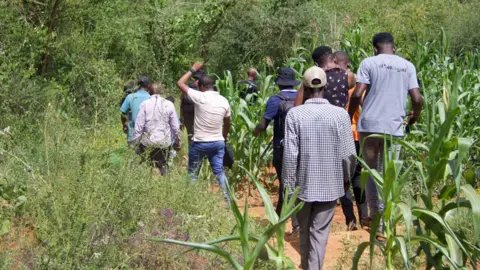 Peter Njoroge / BBC
Peter Njoroge / BBCMukuku had never seen such activity. When the object was carted away later that day by the KSA, the buzz gave way to concerns about what the villagers had had in their midst.
The KSA said its preliminary assessments indicated the object was “a divorce ring” from a space launch rocket.
“Such gadgets are typically designed to fritter away as they re-enter the Earth’s condition or to fall over empty disciplines, such because the oceans,” its statement said the next day.
No-one was injured when it had fallen but some in Mukuku began to complain that the impact of the crash had caused damage to nearby houses.
Christine Kionga, who lives about a kilometre from the crash site, showed us cracks in the concrete of some of the buildings in her home compound. She said they had appeared after the crash.
Other neighbours alleged the structural integrity of their homes had also been affected – allegations that are yet to be substantiated.
“The federal government wishes to search out the homeowners of this object, and get repayment for the ones suffering from it,” Mukuku resident Benson Mutuku told the BBC.
There were reports in the local media that some residents had begun to complain of feeling unwell after exposure to the metallic ring though there was no confirmation from those we spoke to when we visited – nor from the authorities or the KSA.
Nonetheless Mr Mutuku said there were concerns about the long-term effects of possible space radiation.
“This can be a field object and we now have heard in alternative related incidents that there were results of radiation affecting even presen generations and there may be that concern on this folk.”
However tests run later by the Kenya Nuclear Regulatory Authority revealed that while the metal ring did have higher radiation levels than the area in which it was found, they were not at a level harmful to humans.
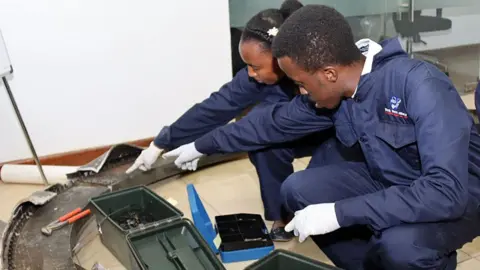 Peter Njoroge / BBC
Peter Njoroge / BBCEngineers from the KSA, which was established in 2017 to promote, co-ordinate and regulate space-related activities in the East African nation, are continuing to run other tests to find out more about the object.
The KSA director general said it was lucky that no significant damage was done when the object hurtled to Earth.
“The latter accountability for any harm or trauma brought about by way of that field object is at the situation in whose jurisdiction that operator will have introduced the thing,” Brigadier Hillary Kipkosgey told the BBC.
According to the Outer Space Treaty, overseen by the UN Office for Outer Space Affairs, “states might be accountable for harm brought about by way of their field gadgets”.
“[The ring] is a regular merchandise in lots of rockets and lots of field gadgets so it tricky to feature it to a particular rocket or field object however we now have leads however as I mentioned our investigations aren’t conclusive,” Brigadier Kipkosgey said.
The BBC showed pictures of the object to the UK Space Agency to get the thoughts of its experts.
“Probably the most believable object it may well be is the higher degree divorce ring from an Ariane rocket in 2008,” its launch director, Matt Archer, said.
“The satellites are positive, however the untouched rocket frame has come via and de-orbited.”
The Ariane was Europe’s main rocket launch vehicle, helping more than 230 satellites into orbit, before it was retired in 2023.
It seems the separation ring may have been orbiting Earth for 16 years before making its unexpected appearance in Mukuku.
This is not the first incident of space junk appearing in East Africa.
Just over a year and a half ago some suspected space debris fell over several villages in western Uganda.
And a few days ago, on 8 January, there were unconfirmed reports of what was believed to be space debris burning brightly in the skies above northern Kenya and southern Ethiopia.
 Peter Njoroge / BBC
Peter Njoroge / BBCAs the space industry grows, it is predicted that such incidents will become more frequent – and African governments may need to invest in ways to better detect this speeding space rubbish.
Nasa estimates there are more than 6,000 tonnes of space debris in orbit at the moment.
There are many different estimates about the chances of such junk hitting someone, but most are in the one-in-10,000 range.
Such statistics are little comfort for Mukuku’s residents, who cannot help thinking of what damage the ring could have caused had it landed in the centre of the village instead of on farmland.
“We’d like guarantees from the federal government that it received’t occur once more,” said Mr Mutuku.
You may also be interested in:
 Getty Photographs/BBC
Getty Photographs/BBC



